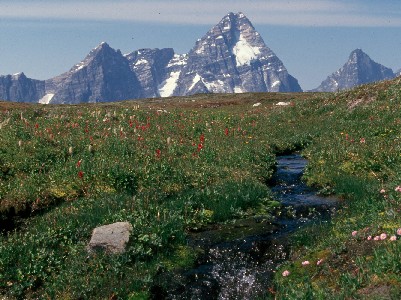Some of these patches could be described, as small glaciers while others when seen from a distance are simply snow that might be there only if there is a cool short summer. I believe we know very little about these alpine areas so close to us, and our watersheds in the southern interior and even less about how climate change is impacting these environments.
Tree stumps at the feet of glaciers not far from here are providing new insights into the accelerated rates at which the rivers of ice have been shrinking due to human-aided global warming.
Geologist Johannes Koch of The College of Wooster found the deceptively fresh and intact tree stumps beside the retreating glaciers of Garibaldi Provincial Park, about 60 km north of Vancouver. What he wanted to know was how long ago the glaciers made their first forays into a long-lost forest to kill the trees and bury them under ice.
To find out, Koch radiocarbon-dated wood from the stumps to see how long they have been in cold storage. The result was a surprising 7000 years. "The stumps were in very good condition sometimes with bark preserved," said Koch, who conducted the work as part of his doctoral thesis at Simon Fraser University which was presented last fall at the Geological Society of America Annual Meeting in Denver.
The pristine condition of the wood, he said, can best be explained by the stumps having spent all of the last seven millennia under tens to hundreds of meters of ice. All stumps were still rooted to their original soil and location.
"Thus they really indicate when the glaciers overrode them, and their kill date gives the age of the glacier advance," Koch explained. They also give us a span of time during which the glaciers have always been larger than they were 7000 years ago – until the recently warming climate released the stumps from their icy tombs.
Koch compared the kill dates of the trees in the southern and northern Coast Mountains of British Columbia and those in the mid and southern Rocky Mountains in Canada to similar records from the Yukon Territory, the European Alps, New Zealand and South America. He also looked at the age of Oetzi, the prehistoric mummified alpine "Iceman" found at Niederjoch Glacier, and similarly well-preserved wood from glaciers and snowfields in Scandinavia.
The radiocarbon dates seem to be the same around the world, according to Koch. It's important to note that there have been many advances and retreats of these glaciers over the past 7000 years, but no retreats that have pushed them back so far upstream as to expose these trees.
The age of the tree stumps gives new emphasis to the well-documented "before" and "after" photographs of retreating glaciers during the 20th century. "It seems like an unprecedented change in a short amount of time," Koch said. "From this work and many other studies looking at forcings of the climate system, one has to turn away from natural ones alone to explain this dramatic change of the past 150 years."
Recently the U.N. Environment Programme reported that data from close to 30 reference glaciers in nine mountain ranges indicated that between the years 2004-2005 and 2005-2006 the average rate of melting and thinning more than doubled.
The findings come from the World Glacier Monitoring Service (WGMS), a centre based at the University of Zurich in Switzerland and that is supported by UNEP. It has been tracking the fate of glaciers for over a century. Prof. Dr. Wilfried Haeberli, Director of the Service said, "The latest figures are part of what appears to be an accelerating trend with no apparent end in sight."
In the BC interior these findings have real consequences. "Heavily-utilized water systems of the western US and Canada, such as the Columbia River, that rely on capturing snowmelt runoff will be especially vulnerable," says the Fourth report of the Intergovernmental Panel on Climate Change (IPCC).
This doesn’t bode well for the Okanagan, which is part of the Columbia drainage and is in a unique geographic location that doesn’t receive the benefits of a great deal of mountain snowmelt. Instead it depends largely on highland plateaus that are themselves becoming drier. The Shuswap drainage on the other hand is fed by the Monashee mountain range a greater source for snowmelt run-off. The Shuswap ultimately feeds into the Fraser and like the Okanagan watershed supplies a growing population with water.
A two degree C warming by the 2040s is likely to lead to sharply reduced summer flows coinciding with sharply rising demand. The IPCC report estimates that Portland, Oregon will by then require over 26 million additional cubic meters of water as a result of climate change and population growth. This will coincide with a fall in summer supplies from the Columbia River by an estimated five million cubic meters.
Meanwhile, just over 40 per cent of the supply to southern California is likely to be vulnerable by the 2020s due to warming triggering losses of the Sierra Nevada and Colorado River basin snow pack.
All of this means that water will become scarcer while our populations increase and demand grows, and as we plan for a limited water supply close to home, we’d better have a plan in place when our neighbors to the south look north for solving their water shortages.
(30)
Don Elzer writes and comments about the future, current affairs, lifestyle and the natural world. He is a director of the Watershed Intelligence Network publishers of The Monster Guide, which can be found at www.themonsterguide.com
He can also be reached by email at: treks@uniserve.com


